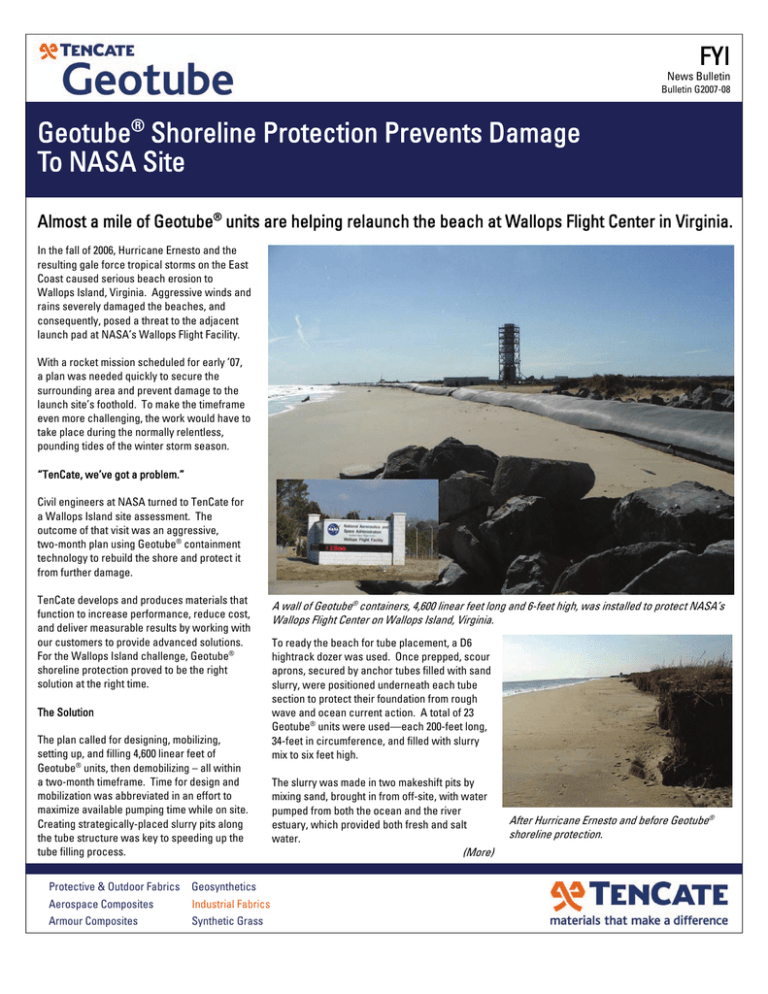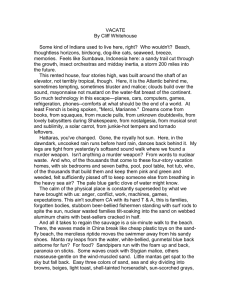
FYI
News Bulletin
Bulletin G2007-08
Geotube® Shoreline Protection Prevents Damage
To NASA Site
Almost a mile of Geotube® units are helping relaunch the beach at Wallops Flight Center in Virginia.
In the fall of 2006, Hurricane Ernesto and the
resulting gale force tropical storms on the East
Coast caused serious beach erosion to
Wallops Island, Virginia. Aggressive winds and
rains severely damaged the beaches, and
consequently, posed a threat to the adjacent
launch pad at NASA’s Wallops Flight Facility.
With a rocket mission scheduled for early ’07,
a plan was needed quickly to secure the
surrounding area and prevent damage to the
launch site’s foothold. To make the timeframe
even more challenging, the work would have to
take place during the normally relentless,
pounding tides of the winter storm season.
“TenCate, we’ve got a problem.”
Civil engineers at NASA turned to TenCate for
a Wallops Island site assessment. The
outcome of that visit was an aggressive,
two-month plan using Geotube® containment
technology to rebuild the shore and protect it
from further damage.
TenCate develops and produces materials that
function to increase performance, reduce cost,
and deliver measurable results by working with
our customers to provide advanced solutions.
For the Wallops Island challenge, Geotube®
shoreline protection proved to be the right
solution at the right time.
The Solution
The plan called for designing, mobilizing,
setting up, and filling 4,600 linear feet of
Geotube® units, then demobilizing – all within
a two-month timeframe. Time for design and
mobilization was abbreviated in an effort to
maximize available pumping time while on site.
Creating strategically-placed slurry pits along
the tube structure was key to speeding up the
tube filling process.
Protective & Outdoor Fabrics
Geosynthetics
Aerospace Composites
Industrial Fabrics
Armour Composites
Synthetic Grass
A wall of Geotube® containers, 4,600 linear feet long and 6-feet high, was installed to protect NASA’s
Wallops Flight Center on Wallops Island, Virginia.
To ready the beach for tube placement, a D6
hightrack dozer was used. Once prepped, scour
aprons, secured by anchor tubes filled with sand
slurry, were positioned underneath each tube
section to protect their foundation from rough
wave and ocean current action. A total of 23
Geotube® units were used—each 200-feet long,
34-feet in circumference, and filled with slurry
mix to six feet high.
The slurry was made in two makeshift pits by
mixing sand, brought in from off-site, with water
pumped from both the ocean and the river
estuary, which provided both fresh and salt
water.
(More)
After Hurricane Ernesto and before Geotube®
shoreline protection.
Sand was added to each pit using an excavator
with a two cubic yard bucket. Water was
added via multiple 6-inch diesel operated dry
prime pumps.
The resulting 10% slurry was then pumped into
the tube’s fill ports at an average of 1,200
gallons per minute using a header system that
branched out into multiple lines. With the
positions of the two slurry pits, the slurry mix
had to be pumped anywhere from 200 feet to
2,500 feet. As the filling process proceeded
down the almost mile-long line of Geotube®
units, the header system had to be assembled
and disassembled many times as the
construction crew got further away or closer to
the slurry pits. Only two of the TenCate
GeoportTM GP 8-inch filling ports were pumped
into at a time, using a 75-horsepower hydraulic
submersible pump with an 8-inch discharge
header.
The Wallops Island restoration was a major
success and paved the way for the NASA
rocket launch to take place as scheduled.
Beach erosion has subsided and it appears the
success is long term. In mid-April, the region
encountered its first nor'easter. And not only
did the Geotube® units stand up impressively to
Mother Nature’s threat, they caused significant
deposition of additional sand on the beach.
“In fact, most of the 4,600’ of Geotube® units
that stood five to six feet tall in most places are
now showing continuous sand build-up on the
ocean side,” according to Project Manager
Dana Trierweiler, of Infrastructure Alternative,
Inc., (IAI.)
Scour aprons were placed under each Geotube®
container and secured with sand-filled anchor tubes.
A header system with multiple flexible lines fed the sand
slurry into the GeoportTM filling ports.
To find out more, call 1-888-795-0808 or visit
www.geotube.com.
Imported sand and water from the ocean and
river estuary were mixed together in two slurry
pits and pumped into the Geotube® units.
Since project completion, the sand continues to
naturally build up on the ocean side of the Geotube®
protective wall, promising long-term success. “I’m very
impressed with the performance of the material so far,”
noted Paul Bull, P.E., NASA—Wallops Flight Facility.
Geotube® is a registered trademark of TenCate Geosynthetics North America © 2007 All Rights Reserved.
Contact:
Vicki Ginter
1-888-795-0808
Cell: 678-227-9944
v.ginter@tencate.com
www.geotube.com
3680 Mount Olive Road
Commerce, Georgia 30529
706-693-1897
Toll Free 888-795-0808
Fax 706-693-1896



